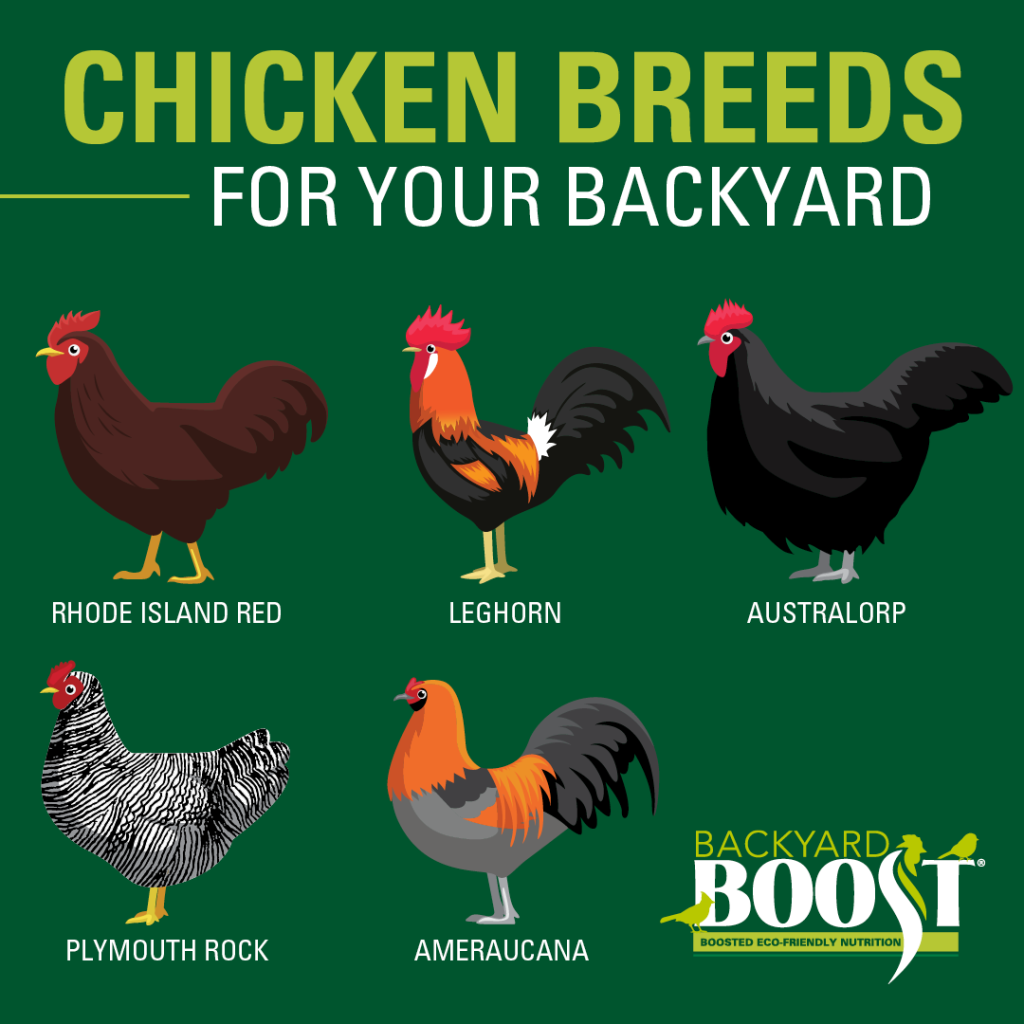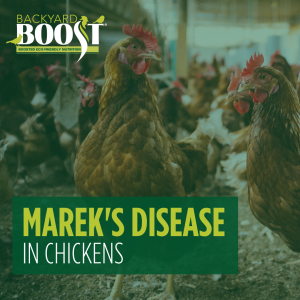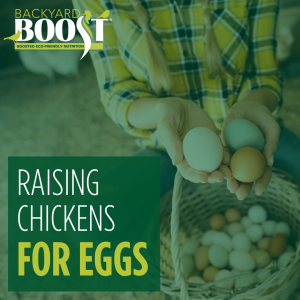
Chicken Breeds
Variety is the spice of life. When selecting the ideal chicken breeds to raise in your backyard, there is more than enough variety to choose from. Do you want to raise birds that are known merely for their productivity? Do you want to raise friendly chicken breeds? Or do you want to raise the exotic breeds that lay a rainbow of colored eggs?
Our team at Backyard Boost® dug in to discover that there are more than just red, white, and black chickens, and they all have distinct benefits. Let’s learn a little about some of the more popular chicken breeds.
Top Egg-Laying Chicken Breeds
Several chicken breeds are renowned for their egg-laying capabilities. Naturally, this makes them the top choice for backyard poultry enthusiasts seeking a steady supply of eggs. But not all layers make great pets or backyard companions. Which do? We’re glad you asked!

Here are 5 of the chicken breeds known for their prolific egg-laying abilities.
Rhode Island Red
A popular breed among backyard chicken keepers, Rhode Island Reds are known for their high egg production of about 250 to 300 large brown eggs per year. They are hardy and adaptable, making them suitable for various climates and conditions.
Rhode Island Reds are a medium to large breed, with hens typically weighing between 6 to 7 pounds and roosters between 8 to 9 pounds. They have a deep chestnut-red color with black tail feathers. Their bodies are well-proportioned, and they have a robust and hardy build. The breed has both single and rose comb varieties. Single combs are upright, while rose combs are lower and more compact, offering better resistance to frostbite in colder climates.
Rhode Island Reds usually start laying at around 5 to 6 months of age and continue to produce eggs consistently. Their reputation for reliable egg production makes them a popular choice for backyard flocks and small-scale egg producers. They are generally calm and friendly, though roosters can be more assertive and protective. Hens are typically easy to handle and work well in backyard environments.
Rhode Island Red Overview
- 250 to 300 large, brown eggs per year
- Begin laying at 5 to 6 months of age
- Hens are generally calm and friendly
Leghorn
This breed, particularly the White Leghorn, is one of the most commonly used for egg production. White Leghorns typically lay about 280 to 320 large white eggs per year. They are energetic and efficient, with a reputation for consistent egg production.
Leghorns are generally small to medium-sized chickens, with hens typically weighing between 4 to 5 pounds and roosters between 5 to 6 pounds. They have a slim and upright build, with a single comb that is large and often falls to one side in hens. The comb is red, and the wattles are well-developed. Leghorns come in various color varieties, but the most common is the White Leghorn. Other recognized colors include brown, black, buff, silver, and others.
They are early layers, often beginning to lay eggs at around 4 to 5 months of age. Leghorns are known for their energetic and active behavior. These birds are alert, curious, and excellent foragers, preferring to be on the move and explore their surroundings.
Leghorns can be skittish and flighty, which makes them less suitable for handling and close contact than other breeds. Keep that in mind if you have small children, as they are generally not considered a cuddly or docile breed. Despite their active nature, Leghorns are hardy and adaptable, able to thrive in various environments and climates.
Leghorn Overview
- 280 to 320 large, white eggs per year
- Begin laying 4 to 5 months of age
- Less friendly than other breeds
Australorp
Originating from Australia, Australorps are prized for their egg-laying prowess, producing about 250 to 300 large brown eggs per year.
Australorps are medium to large chickens, with hens typically weighing between 5 to 7 pounds and roosters between 7 to 9 pounds. They are best known for their glossy black plumage with a green sheen. The black coloration extends to their feet and beaks. The breed has a single medium-sized comb with red wattles and earlobes. The comb stands upright in both males and females. Their general build is robust and well-proportioned, with a strong back and wide chest.
Australorps are considered one of the most reliable breeds for consistent egg production, often laying year-round. They start laying eggs at around 5 to 6 months of age. Australorps are known for their docile and friendly temperament, making them an excellent choice for families or those new to raising chickens.
They are generally calm and easy to handle, getting along well with other chickens and people. This makes them ideal for backyard settings and educational environments. Their adaptability and tolerance for a range of climates contribute to their popularity among poultry keepers.
Australorp Overview
- 250 to 300 large, brown eggs per year
- Begin laying at 5 to 6 months of age
- Hens are docile and friendly
Plymouth Rock
Although they are a dual-purpose breed, raised for both eggs and meat, Plymouth Rocks are reliable egg layers. On average, they will produce about 200 to 280 large brown eggs per year. They start laying eggs at around 5 to 6 months of age and are consistent layers throughout their productive years. They are known for their adaptability and calm temperament.
Plymouth Rocks are medium to large-sized chickens, with hens typically weighing 6 to 7 pounds and roosters between 7 to 8 pounds. They have distinct barred plumage—the barred pattern features alternating stripes of black and white, giving them a classic and attractive appearance. Other color varieties of Plymouth Rock include White, Buff, Blue and Partridge. They have a single comb, red earlobes and wattles. Their legs and feet are yellow.
Plymouth Rocks have a calm and friendly temperament, making them ideal for families and beginning chicken raisers. They are generally easy to handle and get along well with other chickens and people, making them suitable for backyard settings. Their adaptability and tolerance for different climates contribute to their popularity among poultry keepers.
Plymouth Rock Overview
- 200 to 280 large, brown eggs per year
- Begin laying at 5 to 6 months of age
- Known as a calm and friendly breed
Ameraucana
Known as the “Easter Egg Chicken”, these birds will produce up to 180 to 250 large eggs annually. They tolerate all climates and are fun and broody in temperament.
Ameraucanas are medium-sized chickens, with hens typically weighing around 5 to 6 pounds and roosters about 6 to 7 pounds. They have a distinctive appearance, characterized by their beard and muffs, which give them a fluffy face around the cheeks and chin. Ameraucanas have tails and do not have ear tufts.
They come in various recognized colors: Black, Blue, Blue Wheaten, Brown Red, Buff, Silver, Wheaten and White. They have pea combs and slate-colored legs, with earlobes that can be red or blue, depending on the variety.
One of the key features of the Ameraucana breed is its ability to lay blue eggs, which are unique and sought after by many backyard chicken keepers. Ameraucana hens typically lay eggs with colors ranging from light blue to turquoise.
Ameraucanas usually begin laying eggs at around 5 to 6 months of age and you can count on them for consistent production. They are generally docile, friendly, and curious, making them a good choice for backyard flocks and families with children. They are an adaptable chicken breed and can thrive in various climates and management systems.
Americauna Overview
- 180 to 250 large, blue eggs per year
- Begin laying at 5 to 6 months of age
- Docile, friendly and curious
Selecting Chicken Breeds for Your Backyard
Selecting the right chicken breeds for your backyard requires careful consideration of several factors to ensure you choose a breed that suits your needs, environment and goals. Here’s a list of factors to consider when selecting a chicken breed for your backyard.
Purpose
This might seem obvious, but it’s important to pin down why you want chickens. Do you only care about egg production? Do you just want some company in your backyard or a pet for your kids? Some breeds specialize in high egg production, while others are easy to handle. Now of course, there are other reasons to buy chickens—maybe you want chickens for meat, for instance—but for the purpose of this blog, we’re approaching poultry for the purpose of egg production and companionship.
Climate & Hardiness
Consider your local climate and select a breed that can thrive in it. Some breeds are more heat-tolerant, while others acclimate better to cold weather. Hardy breeds are generally more adaptable to temperature fluctuations and weather conditions.
Space & Housing
Review the space available in your backyard and the type of housing you plan to provide. Some breeds are better suited to confined spaces, while others prefer free-range environments with more room to roam.
Egg Production
If you want eggs, consider the breed’s egg production rate, egg size and egg color. Some breeds lay more eggs per year, while others lay larger eggs or unique-colored eggs (like blue or green).
Temperament
Study the breed’s temperament, especially if you have children or other pets. Some breeds are docile and friendly, while others can be more aggressive or flighty. If you are keeping backyard birds and especially if you have children that are naturally curious, you will want breeds that are more friendly or docile. Nobody wants to have a bad experience with animal ownership.
Noise Levels
If you live in a neighborhood with noise restrictions, consider breeds known for being quieter. Roosters can be noisy, so you might choose breeds with quieter hens if noise is a concern. If you live in town, always check with your local ordinances on what you can own in the way of livestock and poultry within the city limits.
Appearance
Breeds come in various colors, patterns and sizes. If the appearance of your flock is important to you, consider breeds with distinctive plumage or unique traits (like feathered legs or crests).
Learn which breeds are fancy appearing and which are plainer, if appearance is important to you.
Broodiness
Some breeds are more prone to broodiness (the desire to sit on eggs and hatch them), which can impact egg production. If you prefer breeds that rarely brood, consider those known for consistent egg production.
Disease Resistance
Certain breeds are more disease-resistant and hardy, making them easier to care for. Consider breeds with a reputation for good health and resilience.
Availability
Particular breeds are more readily available from hatcheries, farm stores or local breeders. Consider the ease of obtaining the breed you desire.
Lifespan & Longevity
Some breeds have longer lifespans or longer productive years. Consider how long you want your chickens to be productive in terms of egg-laying.
By considering these factors, you can select chicken breeds that align with your backyard setup, personal preferences and production goals. Researching different breeds and consulting with experienced poultry keepers can help you make an informed decision. A combination of different breeds can also provide diversity in egg color and contribute to a balanced flock with unique characteristics.
Backyard Boost® Can Help
Regardless of which chicken breeds you select, your goal should be to raise happy, healthy birds. Backyard Boost® is a line of products that supports bird well-being. We offer three products to help ensure your birds have the best life possible.
Backyard Boost® Defense
Backyard Boost Defense is a liquid supplement for poultry that supports digestion and healthy immune response. Ideal for those with chicken heat stress symptoms, Defense promotes water intake and hydration and provides nutrients needed in times of stress.
Powered by AO-Biotics® Amaferm®, this product is a prebiotic research-proven to enhance digestibility. Add Backyard Boost Defense to your chickens’ clean, fresh water daily to help with signs stress to help bounce them back.
Backyard Boost® Daily Essentials
Backyard Boost Daily Essentials is a pelleted protein supplement for poultry that helps maximize digestibility and egg production. In addition to Amaferm, it contains AO-Biotics® EQE, a postbiotic research-proven to enhance egg quality. Daily Essentials provides nutrients needed for overall well-being.
Backyard Boost® Busy Balls
Backyard Boost Busy Balls are a prebiotic treat to bounce your birds’ boredom. They contain Amaferm, a prebiotic research-proven to enhance digestibility and provide digestive support for overall well-being. They help alleviate boredom, which often leads to undesirable behaviors.
Get your Backyard Boost Today!
Backyard Boost is available for purchase online.
Maybe you prefer to shop locally? You can find a dealer near you at our dealer locator.
Stay Up to Date on Backyard Boost News
You can sign up for our monthly newsletter or learn more about caring for your chickens.

